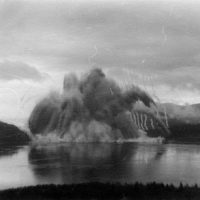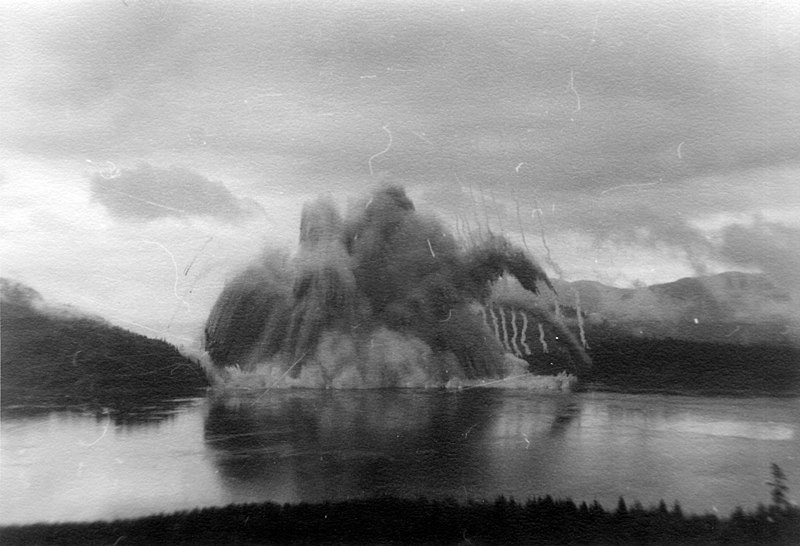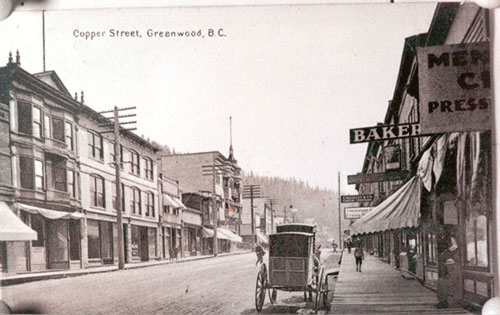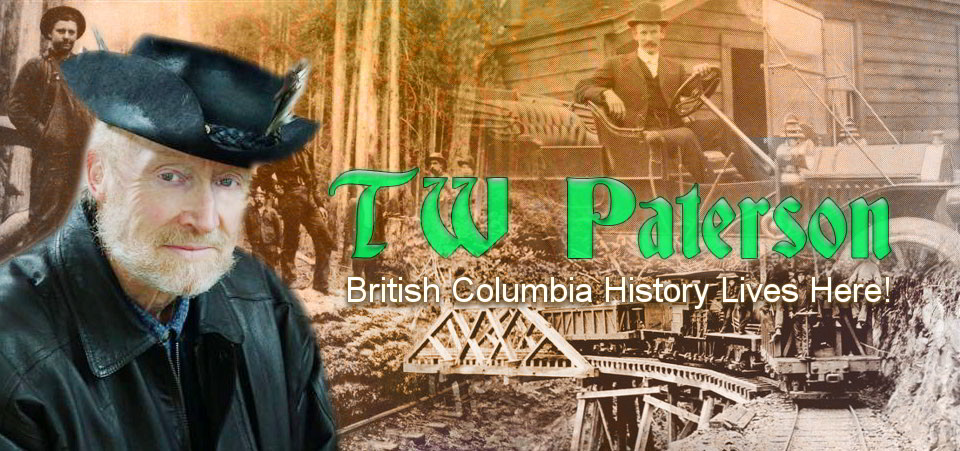Mother Lode Mine Owners Killed Golden Goose

The now-extinct Boundary Country community pf Deadwood City was home to the Mother Lode Mine, one of the province’s greatest copper producers of all time. Until the blowing up of Ripple Rock 45 years later, it held the distinction of having hosted Canada’s biggest man-made explosion.

Prospectors Bill McCormack and Dick Thompson started the ball rolling in May 1891 when their attention was drawn to a prominent outcropping of copper at the 3500-foot level.
The Mother Lode began operation more than four years later, after the partners sold out for $14,000–a pittance even in that pre-inflationary age–and the well-heeled American-owned Boundary Mines Co. set to work. The new management drew praise for their “adequacy of equipment and thoroughness of development work carried out… The surface showings of the Mother Lode may rightly be described as enormous. It is one of the most striking in the district, the outcroppings of the large ore body standing out prominently for 1,000 feet along the hill in which it occurs, and rising to a height of nearly 300 feet…”
Re-organized as the B.C. Copper Co. Ltd. with a capital of $1 million (then an enormous sum that makes the mine’s founders’ payout even more pitiful), the Mother Lode enjoyed “the heaviest mining plant in the district” and used the latest technology, including electrically-detonated blasting. They built their own smelter next door at Greenwood to process their ore, which finally began to flow in 1900, and those of other prominent producers in the area.

All this and a railway, too, spelled prosperity for Deadwood City which had blossomed at an “admirable location, on a series of gently sloping benches, covered with a light growth of timber and with abundance of clear spring water”.
A visiting newspaper reporter predicted that “Altogether the outlook for Deadwood…is excellent for a big payroll, and when the smelter is blown in and ore is being shipped it certainly gives promise of becoming one of the big producing camps of the Boundary district.”
Within a year, in fact,
Deadwood’s mines had produced 100,000 tons of ore–99.5 per cent of which came from the Mother Lode–compelling the latter’s owners to expand their workforce and infrastructure and to blow-in a second furnace at their smelter. By 1902 the Mother Lode, with its workings then extending up to a mile and a-half underground, was the second largest producer in the entire Boundary District. Not even a drop in the price of copper slowed work in this mine whose output, made all the greater because its owners continued to pour money into achieving ever greater efficiencies (such as diamond-drilling), surpassed their smelter’s by-then trebled capacity. Two hundred miners were employed in exploiting a massive “glory-hole” from the surface as a quarry, and underground by means of four miles of tunnels.
For all of their extraction there seemed to be no end in sight of copper-bearing ore and even after a seven-month-long strike the aptly-named Mother Lode yielded a record 250,000 tons of ore (a profit of $200,000 for its shareholders). It’s not surprising that a company official ended his annual report with an optimistic “…The outlook for the ensuing year [is] very satisfactory”. He was right, the mine producing 350,000 tons despite operations being suspended for four months because of a strike by railway workers, and no less than 400,000 tons in 1912.
Incredibly, not even this was good enough for management.
They’d decided that, instead of drilling 1,500 to 2,500 holes at a time that averaged about 13 feet in depth, and detonating them in groups of 25 (requiring a total of 11 tons of blasting powder and shattering up to 175,000 tons of ore in total), they would drill and prime 5,000 holes and fire them all at once!
Mines Inspector James McGregor must have had his tongue in his cheek when he termed this ambitious plan to be “somewhat unique”.
For six months crews drilled the 5,000 holes, wired in a series of 40 shots to a group, and packed them with 50,000 pounds of 40 per cent dynamite.
So great was the planned explosion that it required 16 ½ miles of electric fuse!
Finally came the great day in August 1913. Hundreds of spectators in their Sunday best came from miles around to witness the historic event. To prevent any possibility of injury, all miners were evacuated and three safety-switches were wired into the circuit. The ensuing blast that crumbled almost half a million tons of ore and rock in a matter of moments was said to have been a complete success.
So successful, in fact, that it gave the company two years of ore reserves.
This, ironically, drove down the price of their ore which, although excellent for smelting purposes, was of such low-grade that they had to buy superior grades of ore from their competitors and operate at a loss while scrambling to find new ore-bodies in the Mother Lode.
Increased operating costs–a direct consequence of rock and copper being pulverized together, this created a separation nightmare for the processing techniques then employed–coinciding with a general economic down-turn, meant the beginning of the end for this great mine.
The First World War brought a reprieve but operations ceased soon after Armistice.
Sporadic attempts by other companies to extract the remaining ore reserves (economically viable by the 1950s) confirmed that the 1913 explosion had imperilled further underground exploration and collapsed the rim of the main glory hole, sealing most of the chutes through which much of the ore was moved. The cost of re-boring these holes would have been prohibitive. The owners of the great Mother Lode had literally killed their golden goose.
6 Comments
Trackbacks/Pingbacks
- T.W. PATERSON – BRITISH COLUMBIA’S PIERRE BERTON | richardhughes.ca - […] Mother Lode Mine Owners Killed Golden Goose […]

A great story, in my neck of the woods, too
A great story in any neck of the woods, Liz!
Mr Paterson, understand u interviewed my great grandfather Jock Hamilton, looking for any detailed facts you may have about him. I have the article for his interview from the Halifax Explosion but not much more
Hi, Deandra: When I can I shall pull my file on Jock. I remember him all these years later. Stay tuned. –TW
Comment *who now owns the mine cause their are no signs(stay out) or anything like that.
Go online to the B.C. Dept. of Mines.